Gateway FPD2485W: 24" LCD Beauty or Beast?
by Jarred Walton on February 22, 2007 10:00 AM EST- Posted in
- Displays
Features and Appearance
We've already covered some of the features on the specifications page, but we're going to take a closer look at the display here and provide images from various angles. Assembling the display is extremely simple: after removing the three major pieces from the box (the display as well as the two parts of the base stand), you first attach the circular base to the mounting arm and lock it into place using the provided screw on the bottom of the stand. After that all you have to do is insert the top of the LCD mounting mechanism into the stand and then lower it until it snaps into place.
The base stand provides five inches of vertical travel, which gives you a reasonable amount of height adjustment. The stand also allows you to rotate the LCD and use it in portrait mode. While we can't say using a 24" LCD in portrait mode is something we found to be particularly useful, some people might feel otherwise. One of the great things about having such a large LCD is that it gives you the ability to view two documents (or document pages, web pages, etc.) side-by-side with room to spare, making portrait mode largely unnecessary.
With the display in portrait mode, you don't get quite as much vertical travel, and cable routing can be a bit trickier as well. The display supports auto rotate functionality, so as soon as you rotate the display Windows will automatically recognize the new orientation and change your resolution as appropriate. It is unlikely that this functionality works outside of Windows, due to a lack of native drivers for other operating systems, but we did not actually test this functionality outside of Windows; regardless, as stated already we don't find portrait mode to be particularly necessary on widescreen displays.
Here you can see a shot of the display with the optional speaker bar installed. The speaker bar attaches to the bottom of the LCD and receives power via a short cable that connects to the rear of the main display. The speakers only support stereo audio inputs (standard 1/8" DIN or RCA jacks), but they can try to emulate 3D surround sound if you'd like and the overall quality is pretty good given their size. There are plenty of better sounding speaker options available for $70 or less, but one nice benefit of the attached speaker bar is that you get reasonable quality audio without taking up much desk space. If you're more concerned with eliminating cable clutter than with getting premium quality audio, we would definitely add the speaker bar to a purchase of this display. The speakers also have the potential disadvantage of making portrait mode more difficult to access, so if you do intend to use the portrait mode we would forgo purchasing the speaker attachment.
Here you can see the rear of the unit, with or without the speaker bar. The back of the base stand also includes a small ring that can be used to aid in cable routing. If you would rather do without the base stand, you can of course remove the mounting bracket and use a standard VESA wall mount instead.
All of the input ports are located on the back of the unit, facing downward. One of the advantages of being able to rotate the display is that it makes it easier to install the cables initially. The only ports not located on the bottom of the display are two additional USB ports which are located on the left side. The ability to have the display function as a USB hub can be useful, although personally we prefer the integrated flash memory readers found on competing Dell LCDs. Flash memory readers are cheap, but integrating them into the display is one more way of eliminating cable clutter. If you have a flash reader integrated into your PC, of course, having a second reader on your display is largely superfluous.
We've already covered some of the features on the specifications page, but we're going to take a closer look at the display here and provide images from various angles. Assembling the display is extremely simple: after removing the three major pieces from the box (the display as well as the two parts of the base stand), you first attach the circular base to the mounting arm and lock it into place using the provided screw on the bottom of the stand. After that all you have to do is insert the top of the LCD mounting mechanism into the stand and then lower it until it snaps into place.
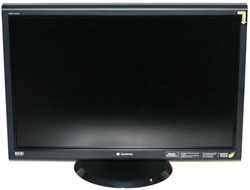 |
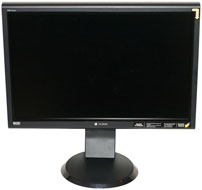 |
| Click to enlarge | |
The base stand provides five inches of vertical travel, which gives you a reasonable amount of height adjustment. The stand also allows you to rotate the LCD and use it in portrait mode. While we can't say using a 24" LCD in portrait mode is something we found to be particularly useful, some people might feel otherwise. One of the great things about having such a large LCD is that it gives you the ability to view two documents (or document pages, web pages, etc.) side-by-side with room to spare, making portrait mode largely unnecessary.
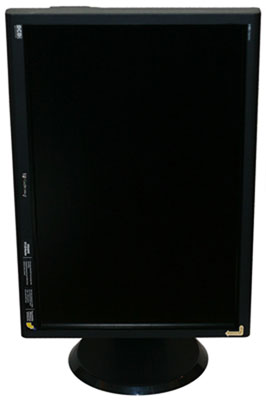 |
| Click to enlarge |
With the display in portrait mode, you don't get quite as much vertical travel, and cable routing can be a bit trickier as well. The display supports auto rotate functionality, so as soon as you rotate the display Windows will automatically recognize the new orientation and change your resolution as appropriate. It is unlikely that this functionality works outside of Windows, due to a lack of native drivers for other operating systems, but we did not actually test this functionality outside of Windows; regardless, as stated already we don't find portrait mode to be particularly necessary on widescreen displays.
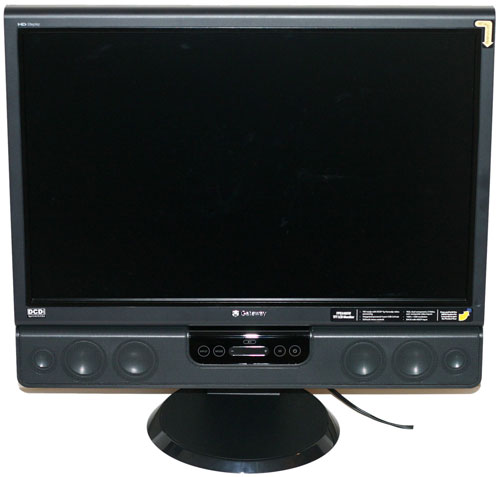 |
| Click to enlarge |
Here you can see a shot of the display with the optional speaker bar installed. The speaker bar attaches to the bottom of the LCD and receives power via a short cable that connects to the rear of the main display. The speakers only support stereo audio inputs (standard 1/8" DIN or RCA jacks), but they can try to emulate 3D surround sound if you'd like and the overall quality is pretty good given their size. There are plenty of better sounding speaker options available for $70 or less, but one nice benefit of the attached speaker bar is that you get reasonable quality audio without taking up much desk space. If you're more concerned with eliminating cable clutter than with getting premium quality audio, we would definitely add the speaker bar to a purchase of this display. The speakers also have the potential disadvantage of making portrait mode more difficult to access, so if you do intend to use the portrait mode we would forgo purchasing the speaker attachment.
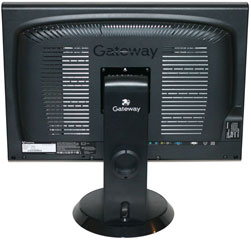 |
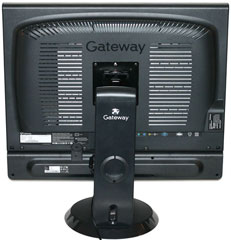 |
| Click to enlarge | |
Here you can see the rear of the unit, with or without the speaker bar. The back of the base stand also includes a small ring that can be used to aid in cable routing. If you would rather do without the base stand, you can of course remove the mounting bracket and use a standard VESA wall mount instead.
 |
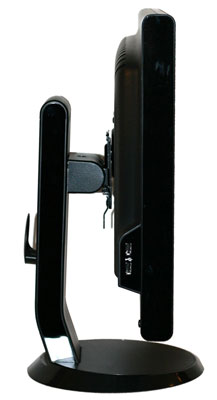 |
| Click to enlarge | |
All of the input ports are located on the back of the unit, facing downward. One of the advantages of being able to rotate the display is that it makes it easier to install the cables initially. The only ports not located on the bottom of the display are two additional USB ports which are located on the left side. The ability to have the display function as a USB hub can be useful, although personally we prefer the integrated flash memory readers found on competing Dell LCDs. Flash memory readers are cheap, but integrating them into the display is one more way of eliminating cable clutter. If you have a flash reader integrated into your PC, of course, having a second reader on your display is largely superfluous.










77 Comments
View All Comments
anandtech02148 - Thursday, February 22, 2007 - link
I find the Westinghouse 37 lcdtv eye candies with all the pluggins you could want, for pc, consoles and whatever hi-def format.and it has native resolution as this Gateway 24.
Dell is losing it touches lately, Westinghouse got a niche here they should runaway with it.
JarredWalton - Thursday, February 22, 2007 - link
I'll see if I can get one for review - I'd certainly like to check out some of the LCD-TVs that can function as computer displays. Of course, pixel pitch is going to be a lot larger on a 37" 1080p display, and while that may be fine for HDTV and gaming purposes, it probably isn't the best for close up computer work.Welshtrog - Thursday, February 22, 2007 - link
I am looking at these displays with interest, however there is nothing in this review that will change my mind regarding retaining my 19" Flat screen CRT just yet, It has good colour accuracy after being set up and no stuck pixelsJarredWalton - Thursday, February 22, 2007 - link
I've got two decent 19" CRTs still (NEC FE991 and Samsung 997DF), and honestly I can't stand using them after I switched to a 24" LCD 18 months ago. I still get irritated by image tear caused by the 60Hz refresh rate, but in all other areas I'm a lot happier with larger LCDs over CRTs. Part of that is simply the expanded screen size, but the reduced footprint is nice as well. I bailed on CRTs a few years ago and haven't really missed them, although I can certainly understand the hesitation. The $600+ prices doesn't help either. :)Justin Case - Thursday, February 22, 2007 - link
The review doesn't address this. I know it says "16 million colors", but all manufacturers say that, and 90% of them use 6-bit panels with automatic dithering. The fact that this is an active matrix TFT, coupled with the very low resposne time suggests that this is a 6-bit panel, like the majority.This means more banding and dithered midtones. Which is probably fine for "office" use, but it makes the LCD unusable for photo work (actually, any LCD short of an Eizo CG is pretty much useless for photo work, IMO, and even those just barely manage to match a high-end CRT), and can make games and movies look pretty bad, too.
To test this, just display a smooth gradient (at the monitor's native resolution) and either look at it very closely or take a photograph of a very small area (about 10 pixels wide), and then increase its contrast until the darkest color is black and the brightest color is white. If you see dithering or banding at the pixel level in the intermediate shades, it's a 6-bit panel.
Aquila76 - Thursday, February 22, 2007 - link
It is an 8 bit S-PVA panel, like the Dell and Samsung 244t. It does 'real' 16.7 million colors, but as I stated previously (and as Jarred can attest) it is nowhere near accurate.Justin Case - Thursday, February 22, 2007 - link
I'd still like to see a "real" test of the screen (by taking a high-speed photo of a small area). Some panels out there do intermeidate colors by flipping between two shades. The panel _accepts_ 8-bit values, but the LCs don't actually have 256 stable transparency levels.Not that I'm very interested in this particular model, but I think it would be useful if review sites actually did that, rather than trusting what the manufacturers tell them.
Even in high-end professional equipment there's a lot of deception. Consumer stuff is even worse (ex., until about a year ago there were almost no real 1920x1080 HDTV sets out there; apart from Sharp, they were all 1366x768 and below, but they all claimed to "support 1920x1080", because they could take it as an input signal).
strikeback03 - Thursday, February 22, 2007 - link
meh, the color calibration results aren't great, considering on my laptop I have an average dE of around .6 and only 3 values over 1 (out of the 42 tested by my Eye-One Display 2). I'll probably still pick one up though, as it's the only locally available 24" display.Other reviews I read online spoke of crushed blacks which calibration did not correct when viewing movies. Any comments on this?
Gary Key - Thursday, February 22, 2007 - link
Jarred is currently reviewing the requests/questions and will have responses later today.
xtknight - Friday, February 23, 2007 - link
When you calibrate using a colorimeter and accompanying software, it only loads the LUT (lookup table) on to the desktop. When you watch a movie, most of the time you're using overlay, which to my knowledge does not allow the fine tuning needed for a lookup table. With VMR you could potentially view videos calibrated, although the last time I tried this I had some odd 16-240 level compression problem.I've been meaning to investigate the overlay "LUT" (or to even find if it exists in the first place). I've seen a function in NVIDIA's control panel API that allows the loading of a LUT onto the overlay surface so I'll see what's up with that.